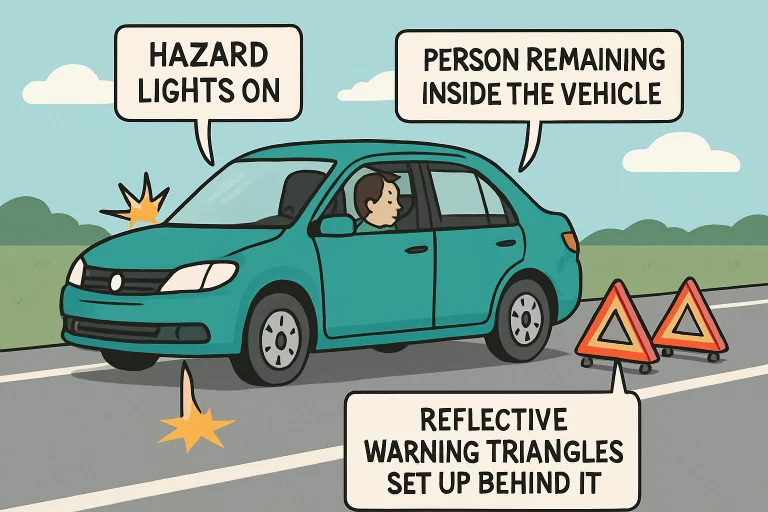Introduction
A vehicle breakdown can catch even the most experienced driver off guard, quickly turning an ordinary trip into a stressful situation. Whether your car loses power on a dimly lit back road, stalls in heavy traffic, or stops in an unfamiliar area, your priority should always be safety—for yourself, your passengers, and those around you. Remaining calm and knowing the proper steps to take can significantly affect how effectively you respond. Understanding how to handle such scenarios helps reduce panic and minimize risk.
Equipping yourself with key information—such as how to pull over safely, what warning signals to use, and what essential items to keep in your vehicle—can help you stay in control. Knowing where to turn for support when professional assistance is needed is also helpful. A resource like https://mwg.aaa.com/automotive/roadside offers practical guidance for navigating roadside situations, helping drivers make informed decisions when breakdowns occur. By planning and knowing how to respond, you can better ensure a safe and steady outcome, even in unexpected moments.
Move to a Safe Location
One of the first and most important actions to take when you realize your car is experiencing trouble is to relocate to a safe area as soon as possible. If you notice warning signs—such as unusual dashboard lights, abnormal engine noises, shaking, or a sudden drop in power—don’t wait for your vehicle to stop moving completely. Turn on your turn signal and carefully steer your car out of active lanes of traffic. Aim to reach a well-lit parking lot, a designated pull-off area, or a rest stop if one is within reach. If your only option is the side of the road, prioritize flat, straight sections well away from blind curves or hills where approaching drivers might not see you in time. The more visible you are to other motorists, the greater your protection against accidental collisions and additional hazards. Use your vehicle’s momentum to your advantage, and remember that keeping as much distance as possible from passing cars is vital for everyone’s safety.
Activate Hazard Lights
As soon as you’ve stopped, immediately turn on your hazard lights. These flashing signals are universally recognized as a distress indicator, warning others that there’s a problem with your vehicle. Activating your hazard lights increases visibility, especially in poor weather, low-light conditions, or heavy traffic. If you’re ever forced to stop near a curve or at the crest of a hill, your hazard lights may be the first sign that alerts an oncoming vehicle to your presence. This simple step can prevent rear-end collisions and ensure you’re easily spotted by emergency responders or roadside assistance. Proper visibility is your first line of defense and an essential part of staying safe during a breakdown.
Stay Inside Your Vehicle
Unless there is an immediate threat—like smoke, fire, leaking fuel, or the risk of your vehicle being struck—remaining inside your car is almost always the best course of action. Your vehicle provides you with a physical barrier from fast-moving traffic and the elements. Keep your seatbelt fastened, doors locked, and windows rolled up. If you’re on a busy roadway, resist the urge to get out and inspect your vehicle. Exiting on the traffic side of your car can be extremely dangerous, especially on highways where vehicles move at high speeds and drivers might not anticipate a pedestrian. If you’re forced to leave your car due to imminent danger, carefully exit through the door that faces away from traffic and move behind a guardrail or another secure barrier before calling for help.
Call for Assistance
Once you’ve secured your surroundings, it’s time to contact help. Use your cellphone to call a reputable roadside assistance provider, your auto insurance’s 24/7 helpline, or local emergency services as appropriate. When making the call, be prepared to describe your vehicle (color, make, and model) and your exact location—this could be a specific exit, a mile marker, notable landmarks, or GPS coordinates. If you’re in an area with poor cell service, text messaging may sometimes get through more reliably than a call. Always carry a portable phone charger or backup battery in your car so you never risk running out of power during a crisis. Timely contact with professionals helps reduce your risk and ensures you spend as little time as possible in a potentially vulnerable situation.
Use Warning Devices
In addition to hazard lights, setting up additional warning signals helps maximize your visibility and alert other drivers to your vehicle’s presence. Reflective triangles, LED flares, or battery-powered safety cones can be strategically positioned to give approaching vehicles plenty of time to slow down and move over. Standard guidelines suggest placing these devices at intervals of 10, 30, and 100 feet behind your car. The further they are spaced out, the more advanced warning you provide to oncoming traffic. Always exercise extreme caution and remain aware of your surroundings as you set these up, facing oncoming traffic so you’re not caught off guard. These visual cues are especially effective at night or in low-visibility conditions like rain or fog.

Be Prepared with an Emergency Kit
Having an emergency kit in your vehicle is essential, not only for breakdowns but for any unforeseen roadside event. Kits should be customized to your local climate and the seasons, but some universal items belong in every car. A bright flashlight and extra batteries are invaluable in the dark, while a first-aid kit can address minor injuries until professional help arrives. Jumper cables are crucial if your battery dies, and a few basic tools—like pliers, screwdrivers, or an adjustable wrench—can help you address minor mechanical issues. In colder months, pack blankets, gloves, and a hat to protect against hypothermia. High-energy snacks and bottled water will keep you nourished if you’re stranded for an extended period. Keep reflective warning triangles or flares in your kit, and always have a portable phone charger available. Review the contents of your emergency kit at the start of every season and replace any expired or depleted supplies to ensure everything is in good working order when you need it most.
Exercise Caution with Strangers
If you find yourself stranded, it’s possible that well-meaning strangers may stop and offer help. While most people have good intentions, stay alert and trust your instincts in every interaction. Politely let anyone who stops know that you’ve already contacted professional roadside assistance or local authorities and that help is coming. Remain inside your vehicle with the doors locked if you ever feel uncomfortable, and do not share personal information with strangers. If someone approaches and makes you uneasy, don’t hesitate to dial 911 or your local emergency number immediately. Your priority is your own safety, so set clear boundaries until a uniformed or clearly identified responder arrives. For more safety tips on interacting with strangers during breakdowns, consult this guide: NHTSA’s 10 Safe Driving Tips.
Preventive Measures
The most effective strategy for avoiding breakdowns is maintaining your car in top mechanical condition through diligent, regular maintenance. Follow your vehicle’s recommended service schedule for oil changes, tire rotations, brake inspections, and fluid top-offs. Pay attention to any dashboard alerts and address unusual sounds or performance issues immediately—ignoring small problems often leads to major repairs. Make a habit of checking your tire pressure and tread before embarking on longer journeys, and keep a close eye on your battery, especially as it gets older or if you notice sluggish starts. Proactive care will not only improve reliability but will give you greater confidence when you’re on the road. For a detailed maintenance checklist tailored to your vehicle, visit this Consumer Reports maintenance guide.
Being prepared with these best practices and resources will give you the confidence to handle any roadside emergency with poise and safety in mind. Stay vigilant, use trusted services, and prioritize your well-being during a car breakdown.







